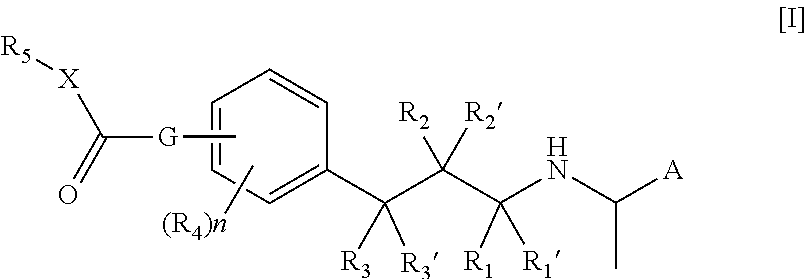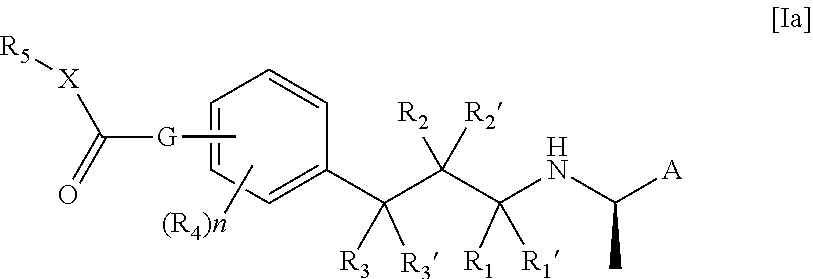Calcium-sensing receptor-active compounds
a receptor and calcium technology, applied in the field of calcium-sensing receptoractive compounds, can solve the problems of osteoporosis, excessive bone resorption, bone pain, etc., and achieve the effect of promoting osteogenesis and advantageous pharmacokinetic or pharmacodynamic properties
- Summary
- Abstract
- Description
- Claims
- Application Information
AI Technical Summary
Benefits of technology
Problems solved by technology
Method used
Image
Examples
embodiments
[0075]In an embodiment of the compound of the formula I or Ia according to the present invention A is naphthyl.
[0076]In an embodiment of the compound of the formula I or Ia according to the present invention A is 4-fluoro-3-methoxy-phenyl.
[0077]In an embodiment of the compound of the formula I or Ia according to the present invention R1, R1′, R2, R2′, R3 and R3′ are all hydrogen.
[0078]In an embodiment of the compound of the formula I or Ia according to the present invention at least one of R1, R1′, R2, R2′, R3 and R3′ is methyl.
[0079]In an embodiment of the compound of the formula I or Ia according to the present invention at least one R1, R1′, R2, R2′, R3 and R3′ is hydroxy.
[0080]In an embodiment of the compound of the formula I or Ia according to the present invention n is 0.
[0081]In an embodiment of the compound of the formula I or Ia according to the present invention n is 1.
[0082]In an embodiment of the compound of the formula I or Ia according to the present invention R4 is hy...
examples
General
[0237]All the starting materials used are commercially available, unless otherwise described.
[0238]For 1H nuclear magnetic resonance (NMR) spectra (300 MHz) and 13C NMR (75.6 MHz) chemical shift values (δ) (in ppm) are quoted, unless otherwise specified; for deuteriochloroform solutions relative to internal tetramethylsilane (δ=0.00) or chloroform (δ=7.26) or deuteriochloroform (δ=76.81 for 13C NMR) standard. The value of a multiplet, either defined (doublet (d), triplet (t), quartet (q), pentet (p), doublet of doublets (dd), doublet of triplets (dt)) or not (m) at the approximate mid point is given unless a range is quoted. All organic solvents used were anhydrous.
[0239]For some of the compounds, only LC / MS data are given. Two methods for LC / MS analysis are used:
Method A
[0240]Analytical HPLC / MS was performed on a Dionex APS-system with a P680A analytical pump and a Thermo MSQ Plus mass spectrometer. Column: Waters XTerra C-18, 150 mm×4.6 mm, 5 μm; solvent system: A=water (0....
preparation 1
[0245](R)-(1-Naphthalen-1-yl-ethyl)-prop-2-ynyl-amine.
[0246]To a solution of (R)-1-naphthalen-1-yl-ethylamine (7.1 ml, 44 mmol) in DMSO (100 ml) was added Cs2CO3 followed by dropwise addition of propargyl bromide with vigorous stirring. After complete addition, the reaction mixture was stirred for 2 hours at rt and filtered. Brine, water and diethyl ether were added. The aqueous phase was separated and extracted three times with diethyl ether. The combined organic extracts were dried over MgSO4 and concentrated under reduced pressure to afford a yellow-brown oil. Chromatography afforded the title compound as a light yellow oil. 13C NMR (75 MHz, DMSO) δ 140.47, 133.49, 130.85, 128.61, 126.81, 125.68, 125.58, 125.24, 122.91, 82.85, 73.55, 51.18, 35.21, 23.21.
General procedure A (Sonogashira)
[0247](R)-(1-Naphthalen-1-yl-ethyl)-prop-2-ynyl-amine (preparation 1) (1.4 mmol, 300 mg) and aryl iodide (1.4 mmol) were dissolved in 3 ml diethylamine in an 8 ml vial. CuI (0.09 mmol, 0.06 eq.) an...
PUM
| Property | Measurement | Unit |
|---|---|---|
| temperature | aaaaa | aaaaa |
| pH | aaaaa | aaaaa |
| concentration | aaaaa | aaaaa |
Abstract
Description
Claims
Application Information
 Login to View More
Login to View More - R&D
- Intellectual Property
- Life Sciences
- Materials
- Tech Scout
- Unparalleled Data Quality
- Higher Quality Content
- 60% Fewer Hallucinations
Browse by: Latest US Patents, China's latest patents, Technical Efficacy Thesaurus, Application Domain, Technology Topic, Popular Technical Reports.
© 2025 PatSnap. All rights reserved.Legal|Privacy policy|Modern Slavery Act Transparency Statement|Sitemap|About US| Contact US: help@patsnap.com



